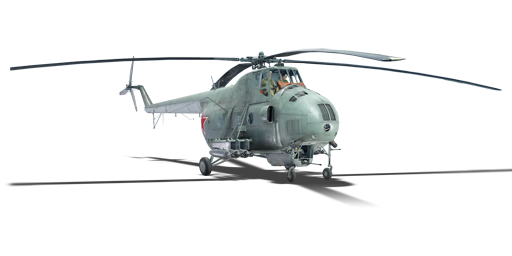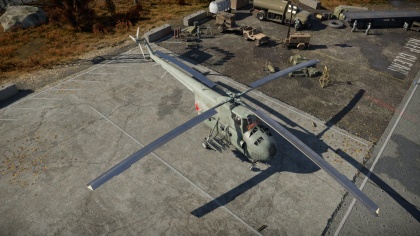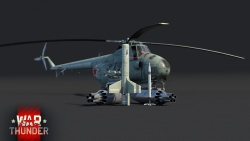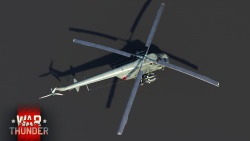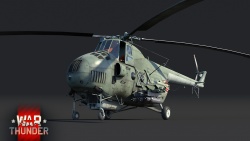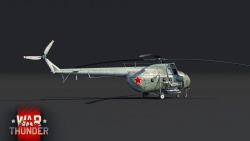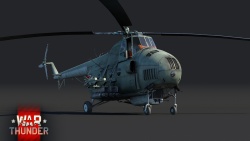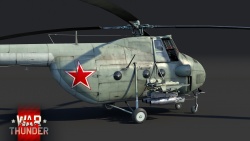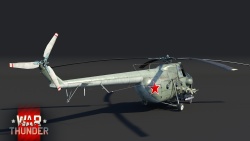Difference between revisions of "Mi-4AV"
m (Edits.) |
|||
| Line 161: | Line 161: | ||
* [https://warthunder.com/en/news/5708-development-uh-1-and-mi-4-early-birds-en [Devblog<nowiki>]</nowiki> UH-1 and Mi-4: Early Birds] | * [https://warthunder.com/en/news/5708-development-uh-1-and-mi-4-early-birds-en [Devblog<nowiki>]</nowiki> UH-1 and Mi-4: Early Birds] | ||
| + | {{AirManufacturer Mil}} | ||
{{USSR helicopters}} | {{USSR helicopters}} | ||
Revision as of 19:08, 31 December 2019
Contents
Description
The Mi-4AV is a Rank V Russian attack helicopter
with a battle rating of 8.7 (AB), 8.0 (RB), and 8.3 (SB). This helicopter was introduced in Update 1.81 "The Valkyries".
General info
Flight Performance
This helicopter is very slow; often times, you will most likely find yourself not being able to go over 200 kph. Additionally, the Mi-4AV has a poor roll rate.
| Characteristics | |||
|---|---|---|---|
| Stock | |||
| Max Speed
(km/h at 500m |
Max altitude (meters) | ||
| AB | RB | ||
| ? | 256 | 6000 | |
| Upgraded | |||
| Max Speed (km/h at ?,000 m) |
Max altitude (meters) | ||
| AB | RB | ||
| ? | ? | 6000 | |
Survivability and armour
The Mi-4AV is a large helicopter and a big target. Unfortunately, to help keep this bird in the air and hauling troops and weapons to the battlefront, sacrifices had to be made. Here, the sacrifice was armour protection. Armour would have weighted down the already heavy helicopter, but the lack of it did not deter the Soviet Union from building these helicopters and using them on a large scale as a showcase piece of their technological prowess. The Mi-4AV turned out to be a do-it-all helicopter despite not having any armour protection.
The pilot must be aware of their surroundings, as they do not want to bring undue notice upon themselves. Strategy plays key in this helicopters ability to sneak into position, let loose a volley of rockets or zero-in an anti-tank guided missile onto an unsuspecting target. Use structures and terrain to act as shields when possible.
Armaments
Offensive armament
It starts with one .50 cal as its only machine gun. This gun has a limited movement, meaning you may not be able to get it on target at times.
Suspended armament
The Mi-4AV can outfit the following suspended ordnance:
- 96 x S5K rockets
- 6 x FAB-100 bombs (600 kg total)
- 4 x FAB-250 bombs (1,000 kg total)
- 4 x 9M17M Falanga missiles and 96 x S5K rockets
- 4 x 9M17M Falanga missiles and 6 FAB-100 bombs (600 kg total)
- 4 x 9M17M Falanga missiles and 4 x FAB-250 bombs (1,000 lb total)
The only suspended armament it comes stock with is 96x S5K dumb rockets. They can be replaced with ATGM's or bombs later with later upgrades.
Usage in battles
Describe the tactics of playing in the helicopter, the features of using vehicles in a team and advice on tactics. Refrain from creating a "guide" - do not impose a single point of view but give the reader food for thought. Examine the most dangerous enemies and give recommendations on fighting them. If necessary, note the specifics of the game in different modes (AB, RB, SB).
Modules
| Tier | Flight performance | Survivability | Weaponry | |||
|---|---|---|---|---|---|---|
| I | Compressor | Flak jacket | Offensive 12 mm | FAB-100 | ||
| II | Helicopter frame | 2P32M/K-4V | ||||
| III | Engine | Replacing helicopter blades | New 12 mm MGs | FAB-250 | ||
| IV | Cover | |||||
Pros and cons
Pros:
- Workhorse
- Several external payload options for weapons
Cons:
- No armour or bullet-proof glass
- Critical components co-located (cockpit, engine, motor and oil coolers)
- Slow and not very manoeuvrable
History
The Soviet Army Aviation owes its emergence mostly to the transport landing helicopter Mi-4. The Mi-4 paved the way for helicopter usage in the Soviet national armed forces. The Korean War was the main impetus in which provided the need for a Mi-4 helicopter which started its official development in the early 1950s. At the time, the American military was widely using helicopters as a force multiplier which enabled troops to advance and reinforce areas much quicker than when travelling by vehicle or more to a pinpoint location without needing finding or building an airfield. Through the use of helicopters, rapid and large scale operations became a possibility that had yet to be exploited to its fullest. At this time, the Americans were using different types of helicopters to do various tasks, depending on what payload was needed. Light helicopters were used for duties such as taking wounded back to hospitals, means of communication and spotters for artillery units. More massive helicopters were utilised for delivering troops, vehicles, supplies and artillery directly to the battlefield. The Korean War demonstrated the increased need for a role which rotor vehicles could fulfil within the Armed Forces.
Once realising their folly of not developing helicopters for inclusion in the armed forces, Soviet leadership decided they needed to make up for lost time and get to work designing and building their helicopter force. In October 1951, the leading aviation designers of the Soviet Union were called to the Kremlin. As a result of the meeting, tasks for developing new rotor vehicles were given to the aviation designers. Here, the Mil Design Bureau specifically was assigned to the designing and creating a landing-transport helicopter which could carry up to 12 persons. Quick work was needed because experimental models were required to be ready for trials one year after receiving this assignment.
Mikhail Mil began to work on a solution; however, unbeknownst to many, he already had a head start on this project which he called the VD-12 or Vertolyot Desantniy (a landing helicopter) which was designed to hold 12 persons. The design of Mikhail Mil’s had been around since the end of the 40s. However, it never went anywhere because nobody was willing to support the project at the time. The lack of support extended from the military through the highest leadership in the country because they did not understand the battlefield benefits this tool would provide their soldiers. It wasn’t until the Soviets were spectators in the Korean War that they saw firsthand the effectiveness of helicopters on the battlefield.
Initially the VD-12 was designed to receive a 1,000 HP engine; however, when the helicopter was ready to begin construction and to receive it, the engine was determined not to be ready for the deadline trials. Mil was then required to redesign the VD-12 to accept a more powerful and heavy engine, the Ash-82 developed by Arkadiy Shevetsov which was a couple of generations newer than the Ash-73TK utilised on the Tu-4 bomber. This piston engine had proven itself an excellent engine when employed on various aeroplanes. To accept this new engine, the helicopter needed to be enlarged to adequately encompass it. Yakovlev DB had intended on providing the rotor, main rotor head, wobble plate, reduction gear and engine for the project, however that was for the smaller VD-12 and all that had to be scrapped for the newer and larger helicopter. Igor Sikorsky developed the S-55 (H-19) which was very similar in size and layout, and Mil decided to model the more modern and larger helicopter off of the aspects of the S-55 which applied to his larger helicopter. The Radial engine was placed in the front nose with the drive shaft passing through the cockpit and turning the rotor, which left the lower section of the helicopter to be a large cargo cabin. Again the cabin needed to be able to hold 12 troops or various military equipment which weighed up to 1,600 kg.
With this plan in action, designers were working almost around the clock to complete the schematics. Within four months of the project starting, the prototype was rolled out of the hanger and prepped for flight. With the radial engine firing, the rotor began to spin, however during acceleration of the motor; the blades started to bend severely, threatening to break apart and destroy the helicopter. The rotor was powered down, and the minds went to work attempting to figure out what the issue was. Mil settled on the problem being the rotors fluttering, which for aircraft surfaces bending or flexion which causes material fatigue and the parts disintegrate thus destroying the entire project. To validate this theory, special weights were built in one night and then installed on the blades. A repeat of the experiment was conducted, and the rotor behaved in a manner it needed to work correctly. Further testing created a blade which was constructed to eliminate any flutter.
Seven months after receiving their assignment to develop and build a helicopter, the first helicopter trials were ready to begin. While the first test had the helicopter tethered to the ground to prevent any mishaps, on the 3rd of June, Vsevolod Vinnitskiy made the first free flight in the new helicopter. At this point, the VD-12 was the most significant and most massive lifting helicopter in the World. With the completion of the state’s trials, the VD-12 began mass production, and its name was changed to Mi-4 and was introduced into service the next year.
In many ways the Mi-4 surpassed the US helicopter H-19’s capabilities as the rear of the Mi-4 could open up and through the use of a ramp, men, vehicles and artillery could quickly be loaded and unloaded. Also installed under the nose of the helicopter was a gunner position with a 12.7 mm machine gun. The Soviet military found many uses for the new helicopter beyond just transporting people and equipment, and as more equipment was outfitted, the helicopter also took on roles such as ground attack and submarine hunter. More than 3,000 Mi-4 helicopters were produced during its years in service and proved to be an essential force multiplier on the battlefield for the Soviet Armed Forces.
Media
- Images
- Videos
See also
- Aircraft of comparable role, configuration and era
- Sikorsky H-34 Choctaw
External links
| Mil Moscow Helicopter Plant | |
|---|---|
| Attack | Mi-4AV |
| Mi-8AMTSh · Mi-8AMTSh-VN · Mi-8TV | |
| Mi-24A · Mi-24P · Mi-24V | |
| Mi-28N · Mi-28NM | |
| Mi-35M | |
| Export | ◊Mi-8TB |
| ▂Mi-24D · ◔Mi-24D · ◔Mi-24V · ◔Mi-24P · ◊Mi-24P · ◄Mi-24P HFS 80 · Superhind | |
| Mi-28A | |
| ▄Mi-35M | |
| USSR helicopters | |
|---|---|
| Attack | |
| Hound | Mi-4AV |
| Hip | Mi-8AMTSh · Mi-8AMTSh-VN · Mi-8TV |
| Hind | Mi-24A · ▂Mi-24D · Mi-24P · Mi-24V · Mi-35M |
| Havoc | Mi-28N · Mi-28NM |
| Helix | Ka-29 |
| Hokum | Ka-50 · Ka-52 |


